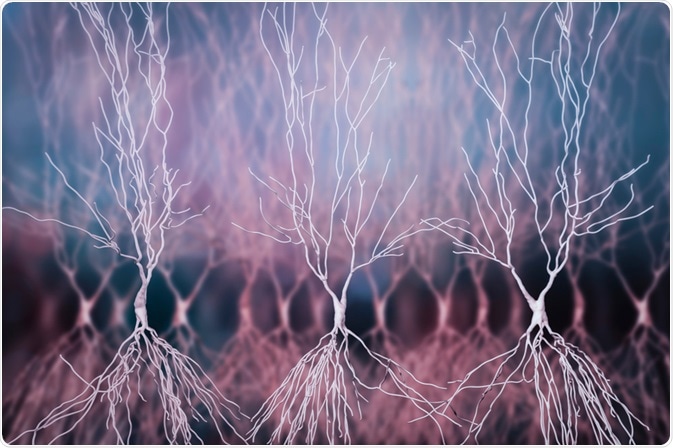Memory is the term used to describe the storage of the vast amount of information the brain uses to perform various cognitive tasks.

Image Credit: Kateryna Kon/Shutterstock.com
Different types of memories are stored by the human brain for different lengths of time. Short-term or working memory refers to the memory of something that has just been read, for example, so that it can be checked or looked up later. The working memory is limited in capacity and these memories only last for a few seconds or hours.
The capacity of long-term memory, on the other hand, is unlimited and long-term memories can last for many years.
Sensory memory is used to store information obtained from the senses for later use.
Declarative and non-declarative memories
Memories can also be categorized based on memory and whether a person is aware of it. Explicit or declarative memories are those that people are aware of such as what the name of a country’s capital is or where they went on their last birthday.
Implicit or non-declarative memories accumulate unconsciously, and they may influence the body’s automatic responses. Examples would include a person’s heart rate increase if they saw something they fear, or their mouth starting to water if they saw their favorite food. Nondeclarative memories also include procedural memories, which are the memories the body uses to remember a skill such as riding a horse or playing the piano.
Explicit memories generally form more easily than implicit ones; memorizing a birthday event takes less time than learning to play the piano. However, implicit memories last a lot longer, with a person unlikely to forget how to ride a horse, once they have learned to, for example.
The brain is made up of four main regions
Memory formation and storage involves many parts of the brain at the same time. The brain is made up of four main regions which include the cerebrum, the cerebellum, the limbic system, and the brain stem. The cerebrum is the largest, most recently evolved and most developed part of the brain and is made up of two hemispheres (the right and left) and four types of lobes (frontal, occipital, temporal, and parietal).
- The frontal lobes are involved in thinking, organization, short-term memory and problem-solving.
- The occipital lobes process images a person sees and links them with ones that have been stored in the memory.
- The temporal lobes process sensory information such as temperature, touch, smell, taste and sound and are also involved in the storage of memories.
- The parietal lobes also process sensory information.
The outermost layer of the cerebrum, the cerebral cortex, plays a role in higher brain functions such as memory and language.
Studying amnesia to understand the neurophysiology of memory
Amnesia typically occurs following trauma to the brain as a result of a stroke, head injury or chronic alcoholism, for example.
Amnesia is categorized into two main types: retrograde amnesia and anterograde amnesia. The retrograde form refers to when a person no longer remembers things they used to remember before the brain trauma happened. Anterograde amnesia refers to when someone is no longer able to form new memories after the trauma.
One well-known case of anterograde amnesia involved a man called Henry Molaison who had areas of his brain surgically removed to resolve his seizures. Following the procedure, he could still remember most of his childhood, but he could not form explicit memories and people who had known him for years had to introduce themselves afresh every time they met him since the procedure.
Studying such individuals, as well as brain damage in animal models, has enabled researchers to monitor how different types of memories form. Research suggests the different types of memory such as short- and long-term memory or declarative and non-declarative memory are formed in different ways and stored in different parts of the brain. For example, a non-declarative memory that manifests as a fear response is stored in an area of the brain called the amygdala; a procedural memory involving a learned skill is stored in the striatum and a declarative memory such as recalling a country’s capital involves the hippocampus.
Forming, storing and recalling memories
Researchers think memories are stored within groups of interconnected nerve cells referred to as assemblies that are triggered together on exposure to a stimulus, such as the smell of a certain food or hearing a friend’s voice. The greater the number of nerve cells that fire simultaneously, the stronger the interconnection within an assembly. This means that if the cells are exposed to the stimulus again, all cells within the assembly are more likely to get triggered and fire.
How active such cells are within an assembly is thought to determine the memory experienced, but researchers are still investigating this process.
Memory consolidation
For a short-term memory to turn into a memory that can be stored in the long term it has to undergo “memory consolidation,” a strengthening process that is thought to occur in several ways. One way is through a process referred to as long-term potentiation, where single neurons change in a way that enables them to grow and alter their communication with nearby neurons. This modification changes how the neurons connect in the long term and that strengthens the memory.
Memory consolidation is one of the major roles of sleep in humans. Thus, sleep is essential not just to physical functioning, but also to mental acuity.
Sources
Memory. Encyclopedia Britannica. Graham Ratcliffe. Available at: https://www.britannica.com/science/human-nervous-system/Memory
Brain Physiology. Phsiologyinfo.org 2017. Available at: https://www.ncbi.nlm.nih.gov/books/NBK551718/
Human memory: How we make, remember and forget memories. National Geographic 2019. Michael Greshko. Available at: www.nationalgeographic.com/.../
https://ncbi.nlm.nih.gov/pmc/articles/PMC5491610/
https://www.nature.com/articles/s41593-019-0467-3
Further Reading